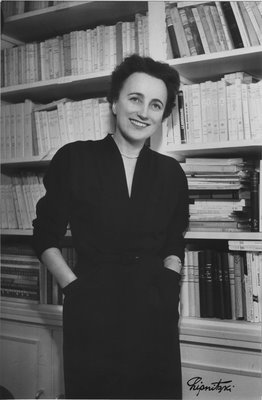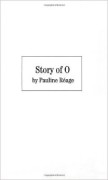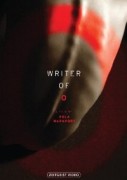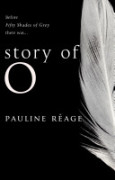
This month the BDSM Classics Reading Group read The Story of O by Pauline Réage. Faced with the prospect of rereading it yet again, I groaned and went for background reading instead.
And wow.
Now I want to be Pauline Réage!
One day a girl in love said to the man she loved:
“I too could write the kind of stories you like …”
“Do you really think so?” he answered.
The Story of O is a love letter! That explains so much.
You know the story. It’s a classic of our tribe. The heroine is first brought to a château of sexual slavery by her lover, then given to another man, with interludes of lust for other women. The tale ends with her reduction to a naked, masked party ornament.
And she glories in it. In the detached and recursively reflective voice of a French intellectual. Because, of course, she was. Pauline Réage, author of The Story of O, was also Dominique Aury, one of the leading lights of the postwar French literary scene.
Also Anne Desclos, a single mother who lived with her parents.

Also the lifelong lover of her equally brilliant colleague, Jean Paulhan, whom she met in the Résistance.
You can watch interviews with her in the documentary Writer of O. So I did, and at first I could not make sense of what I was seeing.
A literary giant who chose a pen-name that resounds etymologically with power and gold? A woman who liked to dress as a prostitute and walk the streets at night? [source]
And her face is a shy version of Anne Frank’s three-cornered zest for life. She has the exact same smile as a young woman and as a little old lady – now mischievous, now shrinking from attention, always open and innocent.
This confused the heck out of me. But it actually kind of fits with what her publisher and lover said about her book. Which I thought I had read.
“The Story of O is a very decent book. It simply recounts a story, a tale of scandalous doings, but it does so without the slightest excess.”
“In O, there also blows some indefinable, always pure and violent spirit, endless and unadulterated.”
Decency? Purity?
But yes, it’s there. And they put their finger on it, that’s exactly how it differs from its pornographic neighbours. There is no titillation, no leering. Just love and desire and submission. That is the alchemy which transforms innocence into bacchanalia intact.

And now it makes sense. Of course there is no prurience, because that is impossible without shame.
Of course she liked the eyes of men on her body in the shiny black knee-length dress of a prostitute, because it was about feeling powerless and available to their desire. (But always with a male friend to act as lookout. Sensible girl.)
And of course she could go to work as a senior editor alongside Albert Camus with that timid and friendly smile, because she had total confidence within her chosen posture of modesty and humility.
We think of innocence as ignorance. But in her case it was the opposite. She had read Sade, and this is all she had to say about him:
“So it was that Sade’s castles, discovered long after I had silently built my own, never surprised me, as I was not surprised by the discovery of his society, The Friends of Crime: I already had my own secret society, however minor and inoffensive. But Sade made me realise that we are all jailers, and all in prison, in that there is always someone within us whom we enchain, whom we imprison, whom we silence.”
She’s talking about 120 Days of Sodom. The Friends of Crime consume faeces incessantly. Children are tortured to death in the most horrible ways. Most kinksters who encounter this text trip over themselves in haste to disavow Sade as one of us. But the young Pauline Réage recognised kinship, and wasn’t even shocked.

No shame, no fear. She simply took it for granted that horrible desires are universal. And in order to be at peace with that, you need utter faith in your moral sense about which ones to act on in real life. She had that. Do we?
To her contemporaries, it seemed incredible that a woman broke this barrier. But I think maybe it almost had to be a woman, it had to be a submissive. Someone whose whole cultural milieu made sense of submission as the only acceptable form of love and desire for her gender. Someone who saw no contradiction between the joy of sexual victimisation and obedience to a moral sense.
“Whence came to me those oft-repeated reveries, those slow musings just before falling asleep, always the same ones, in which the purest and wildest love always sanctioned, or rather always demanded, the most frightful surrender, in which childish images of chains and whips added to constraint the symbols of constraint, I’m not sure which.”
Childish?
Sade knew he was evil. Pauline Réage knew she was not. She saw the drive for self-destruction in her own novel, and it didn’t rip her apart, because she saw the same thing in Quietist mysticism. In one interview she observed that there is nothing more immodest than prayer, because it puts you at the mercy of something or someone else.

Yes, I am absolutely her fangirl now. One of my doms called me their time machine into the past. In a world where kink means sex, it feels so good to find someone else who thinks of submission and sexual desire as love and outraged modesty.
Of course the match is not perfect by any means. Some of it is just our kinks. She’s the kind of sub who is into her own submission; for me it is someone else’s sadism. And I just can’t get that excited about women.
But I’m not that brave, either. She acknowledged frightening moralities: the slave’s manipulation of the master, the vindictive thrill of betrayal, the fulfilment of self-abnegation in death. Plus a thousand other paradoxes, some of which have become clichés, while others have yet to be rediscovered.
Most alien of all, she never mentions the strangeness of sexual submission alongside intellectual equality. Maybe it’s because she couldn’t risk betraying her identity; maybe it’s because she and her lover could so easily fill in the blanks while she read it aloud to him. [source]

But I think the answer is much simpler. Maybe it was a time when this wasn’t strange, because there was no equality between men and women.
And this is a big gap for me, because by God I love it when my pride is outraged alongside my modesty. So I’m glad that our canon now also includes Carrie’s Story and its sequel, which are all about this incongruity and form a brilliant commentary on O.
But no one has yet dethroned “the most ardent love letter any man has ever received.” [source] I’m so relieved that Jean Paulhan appreciated what he was getting.

Thanks for this superb article. I am going to have to dust off my Story of O this weekend (somewhere in the attic) and read it again.
Anne Desclos was a fascinating woman. She lived and wrote in very interesting times.
BTW Great blog – so happy to have found it.
shiny
Thanks! I found it really interesting where she does and doesn’t report O’s feelings and reactions. And one of the group members said he’s going to reread it looking for the religious language this time. I’m curious what you’ll find!
This is a great read, I am very intrigued about this author. I will have to read these finds. Thanks!!
Thank you! I was actually kind of worried that I had written something which would only make sense to myself, so it’s a relief to hear you enjoyed it.
I am very fond of Story of O but count 120 Days of Sodom as the best book I’ve ever read: it draws disgust not from your throat but from the pit of your stomach and for words to acheive that is truly something.
… You have a strong stomach! I guess I think it’s harder to juxtapose beauty and horror than to just wallow in a cesspit. But to each their own!